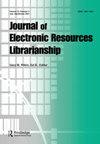开放教育资源(CLIPP, 45)
Q3 Social Sciences
Journal of Electronic Resources Librarianship
Pub Date : 2022-06-24
DOI:10.1080/1941126X.2022.2064142
引用次数: 0
摘要
负责部门内的各种活动和政策。虽然讨论了这些平台的缺点和挑战,但总体报告表明,这些工具的使用极大地改善了技术服务部门工作人员之间的沟通、协作和士气。本节的其余章节重点介绍了在本部门内促进健康沟通的其他策略。一个案例研究展示了一个大型城市图书馆如何在其技术服务部门内部培养积极的关系,矛盾的是,通过第三章“撤退共同前进”中的有组织的撤退,走出图书馆。然后,下一章继续展示了与项目中的每个人进行清晰的多向沟通如何帮助在一个大型大学图书馆系统的技术服务部门内培养积极的环境。本书的第二部分着眼于技术服务之外但在图书馆内部的交流。本节的第一章详细介绍了一家图书馆如何开始提供编目和元数据主题的培训机会,以便图书馆的其他部门能够更好地理解该部门提供的真正价值。本节强调的其他案例研究包括成功使用协作项目管理工具的一个图书馆,以及开发内部电子资源票务系统的另一个图书馆。本节最后一章讨论了技术服务部门和学科馆员之间的沟通问题,以及他们如何使用调查和焦点小组来采用更多数据驱动的方法来填补图书馆内部的沟通空白。本书的最后一部分着眼于完全在图书馆之外传播价值的策略。对于本节中的许多章节,读者只是更广泛的大学或组织,例如通过一系列渠道营销图书馆的章节。其他章节着眼于与特定受众的协作,例如集合开发对话和教员,或者发现接口增强和IT部门。最后一章叫做“抱最好的希望,做最坏的准备”,总结了最后一节的内容:永远保持乐观的态度,但也要为逆境做好准备。对于许多技术服务部门来说,在图书馆之外进行清晰的沟通可能是一个更大的挑战,但对他们来说,在图书馆之外推广和进一步开展工作是必要的,本节提供了如何最好地做到这一点的实际示例。总的来说,这本书说明了技术服务部门有许多不同的策略来更好地传达他们的价值。除了富有洞察力的案例研究,这本书还包含了调查的例子,信息图表,以及一个附录,其中包含了支持故事出现的各种内容。实际上,这本书可以作为一个有用的现代指南,为其他技术服务部门谁正在寻求改善他们的沟通。本文章由计算机程序翻译,如有差异,请以英文原文为准。
Open educational resources (CLIPP, 45)
for the various activities and policies within the department. While drawbacks and challenges of these platforms are discussed, the overall report is that the usage of these tools greatly improved communication, collaboration, and morale among those working in technical services departments. The rest of the chapters in this section highlight other strategies for fostering healthy communication within this department. One case study showed how a large urban library fostered positive relationships within their technical services department by, paradoxically, going outside of the library via organized retreats in Chapter 3: “Retreating to Advance Together.” Then the next chapter goes on to show how clear multi-directional communication with everyone involved in projects helped foster a positive environment within one large university library system’s technical services department. The second section of this book looks at communication outside of technical services but within the library. The first chapter in this section details how one library started offering training opportunities on the topics of cataloging and metadata so that the rest of the library can better understand the true value provided by the department. Other case studies highlighted in this section include one library that successfully used a collaborative project management tool, and another that developed an internal e-resources ticketing system. This section wraps up with a chapter looking at the communication breakdown between technical services departments and subject librarians, and how they used both surveys and focus groups to take a more data-driven approach to fill communication gaps within the library. The final section of this book looks at strategies for communicating value wholly outside of the library. For many of the chapters in this section, the audience is simply the broader university or organization, such as with the chapter on marketing the library through a range of channels. Other chapters looked at collaborations with a specific audience, such as collection development conversations and the faculty, or discovery interface enhancements and the IT department. The final chapter is called “Hope for the Best, Prepare for the Worst,” which sums up this entire final section: always keep an optimistic outlook but also be prepared for adversity. Communicating clearly outside of the library may be more of a challenge for many technical services departments, but it is imperative for them to both promote and further their work outside of the library’s walls, and this section provides practical examples of how to best do this. Overall, this book illustrates that there are many different strategies for technical service departments to better communicate their value. In addition to the insightful case studies, this book also contains examples of surveys, infographics, and an appendix complete with various kinds of content that support the stories appearing within. Practically, this book can serve as a useful modern guide for other technical services departments who are looking to improve their communication.
求助全文
通过发布文献求助,成功后即可免费获取论文全文。
去求助
来源期刊

Journal of Electronic Resources Librarianship
Social Sciences-Library and Information Sciences
CiteScore
1.50
自引率
0.00%
发文量
46
期刊介绍:
A journal for information professionals who work with managing electronic resources in libraries The Journal of Electronic Resources Librarianship (renamed from The Acquisitions Librarian to reflect the journal"s broader focus) provides a much-needed scholarly forum for librarians and other information professionals. This peer-reviewed quarterly journal addresses evolving work-related processes and procedure, current research, and the latest news on topics related to electronic resources and the digital environment"s impact on collecting, acquiring, and making accessible library materials. The journal provides opinion pieces, the latest news, book reviews, conference presentations, and e-resources related updates.
 求助内容:
求助内容: 应助结果提醒方式:
应助结果提醒方式:


